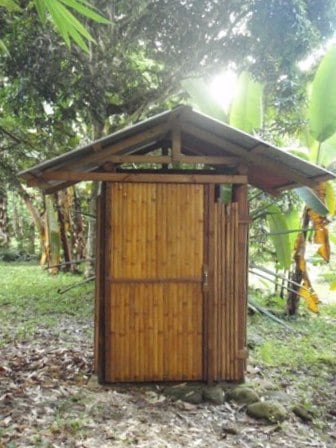
This composting toilet is in use at New Dawn Herbalism School and Farm in Costa Rica.
For more info about New Dawn contact: thenewdawncenter
Priorities for design and construction
- Low cost
- Reduce or eliminate underground water contamination
- Prevent pathogen parasitic infections through manipulation of humanure
- Include bamboo as a renewable resource in the construction
Construction Procedure
- A hole was excavated in the earth at the toilet site 1m wide and 1m deep
- A 1mx1m culvert pipe made from concrete was lowered into the hole
- A cement floor was added to the bottom of the culvert pipe to prevent fecal matter from leaking into the soil, and potentially contaminating the underground water table.
- A top for the toilet was constructed using a wooden form poured with fine sand and cement. 1/4inch rebar was used to strengthen the 2 inch thick slab.
- The top of a plastic 5 gallon water bottle was used as the urine trap and was attached to the bottom of the top for the toilet. The trap was connected to a flexible plastic tube which exits through a hole in the concrete culvert pipe into a small drain field.
- A wood trap door was construct as the removable top for using the toilet.
- The design of the compost toilet was based on the Japanese style toilet, therefore, no toilet seat was required.
- A 4 inch PVC pipe was attached to the top of the compost toilet as an air vent. A screen was used to cover the end of the pipe to prevent insects from invading the toilet.
- A 5 gallon bucket with sawdust is placed in the area so that each time the toilet is used a cover of saw dust can be applied to the fresh material.
- Another smaller bucket is included with water to flush the urine trap with a cup of water after each use to cut down the odor.
Results
- The compost toilet is odor and insect free
- The toilet uses minimum water and does not contaminate the environment
Plans for the future
A second annex will be constructed to the present compost toilet when it fills up with humanure. The second annex will then serve as the in service toilet, while the first toilet will be topped with an air tight lid and allowed to decompose for a year or more until the second annex toilet is filled. At this point, the first toilet will be cleaned out with a long handled shovel and the humanure will be applied to trees on the farm. The toilet will then be put into service again, and the second toilet will be topped and left to decompose. In this manner the humanure is manipulated only once after more than a year’s time to insure potential pathogen microorganisms are eliminated through biological decomposition.
Approximate cost of this project
(in Costa Rica)
- 2 1m culvert pipes - $70
- Cement - $10
- Free materials- stones, bamboo, recycled zinc roofing and wood
Gallery
-
Instructions for use
-
Interior
-
Where the waste goes
-
The vent



